As always, which books/covers/authors intrigue you? Which have you read? Disliked? Enjoyed?
1. Worlds Without End, Clifford D. Simak (1964)
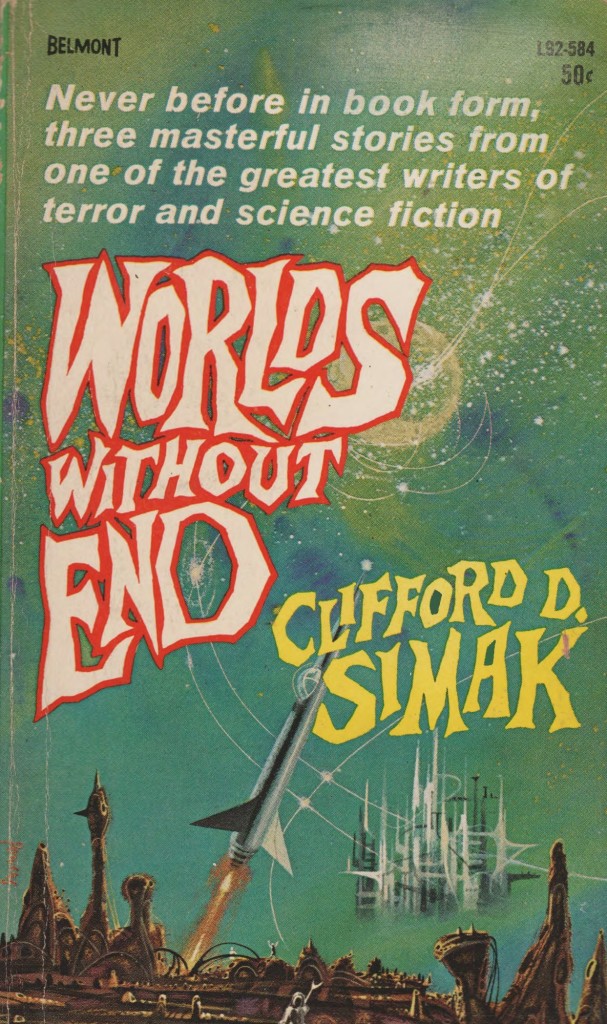
Richard Powers’ cover for the 1st edition
From the back cover: “A link between yesterday and the tomorrow that was here already…. Dreams constructed and maintained by society…. A world-to-world search for an elusive secret…. The bizarre, weird, strange creations of things and worlds only Clifford D. Simak could have written… and make believable.”
Contents: “Worlds Without End” (1956), “The Spaceman’s Van Gogh” (1956), “Full Cycle” (1955)
Initial Thoughts: In the first five years of my SF adventure, I read countless Clifford D. Simak novels—from Way Station (1963) to Cemetery World (1973). I’m not sure I’ve read a single Simak short story!
EDIT: I have read exactly one Simak short fiction for my generation ship series: “Spacebred Generations” (variant title: “Target Generation”) (1953)
Richard Powers’ gorgeous cover also proved too hard to resist.
2. The Hercules Text, Jack McDevitt (1986)
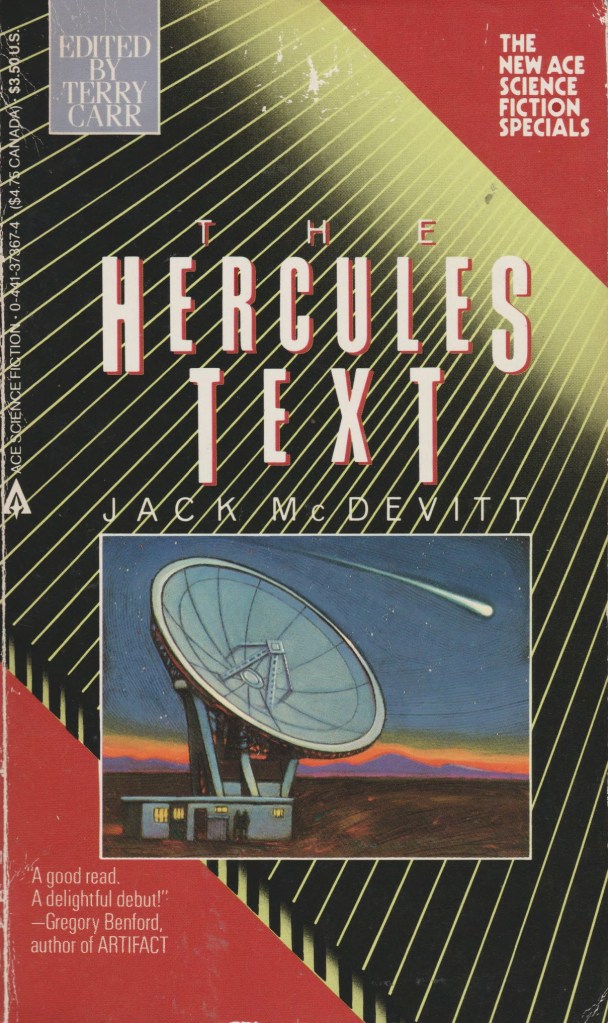
Earl Keleny’s cover for the 1st edition
From the back cover: “From a remote corner of the galaxy a message is being sent. The continuous beats of a pulsar have become odd, irregular… artificial. It can only be a code.
Frantically, a research team struggles to decipher the alien communication. And what the scientists discover is destined to shake the foundations of empires around this world—Wall Street to the Vatican.
Initial Thoughts: Sounds like a completely bland first contact premise (but in the hands of a good author it can transfix)… But I haven’t read any of McDevitt’s work and I always like to start with earlier works.
3. New Worlds Quarterly #1, ed. Michael Moorcock (1971)

Richard Powers’ cover for the 1971 US edition
From the back cover: No back cover information about the stories.
Contents: Thomas M. Disch’s “Angouleme” (1971), J. G. Ballard’s “Journey Across a Crater” (1970), M. John Harrison’s “The Lamia and Lord Cromis” (1971), Brian W. Aldiss’ “The Day We Embarked for Cythera” (1970), John Sladek’s “Pemberly’s Start-Afresh Callipe or, The New Proteus” (1971), Keith Roberts’ “The God House” (1971), David Redd’s “The Prisoners of paradise” (1966), John Sladek’s “The Short, Happy Wife of Mansard Eliot” (1971), J. G. Ballard’s “A Place and a Time to Die” (1969), Barrington J. Bayley’s “Exit from City 5” (1971)
Initial Thoughts: This is the first volume of a “new chapter” in the history of New Worlds magazine. Moorcock transformed the illustrious magazine into a quarterly publication in book form that produced ten volumes between 1971-1976. I find it hard to resist a magazine packed with Ballard, Sladek, Roberts, and Aldiss stories (among others). As with the earlier New Worlds magazines under Moorcock, the interior art of this volume is top-notch. Here are two examples:
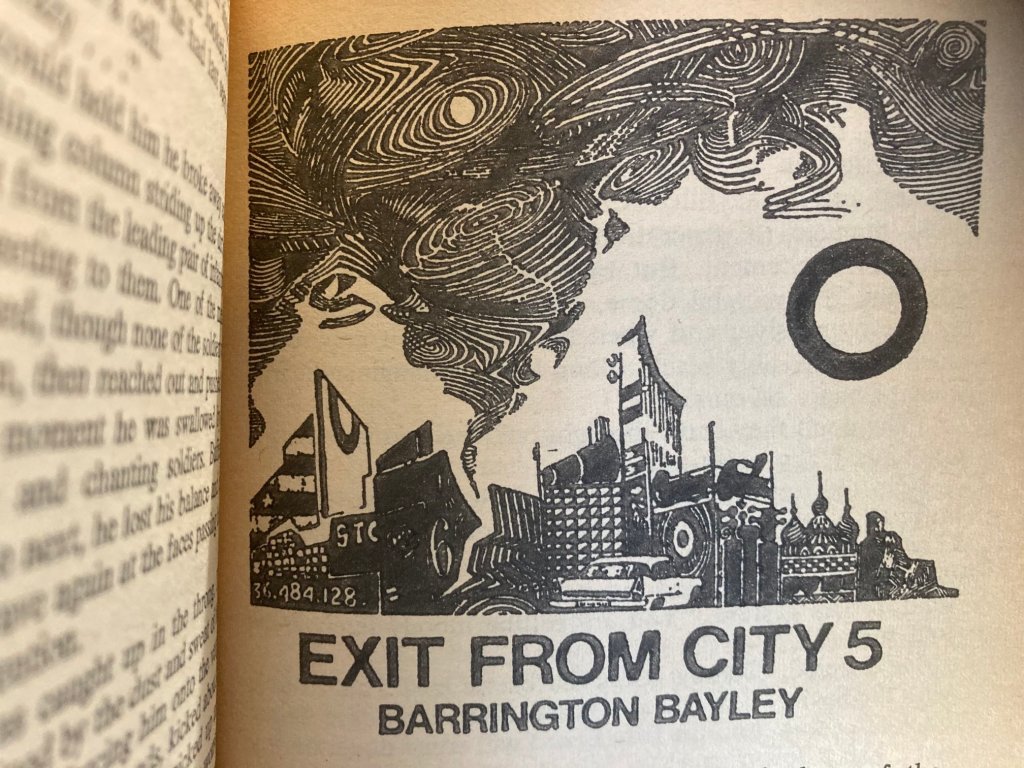
Brian Vicker’s interior art for Barrington J. Bayley’s “Exit From City 5”
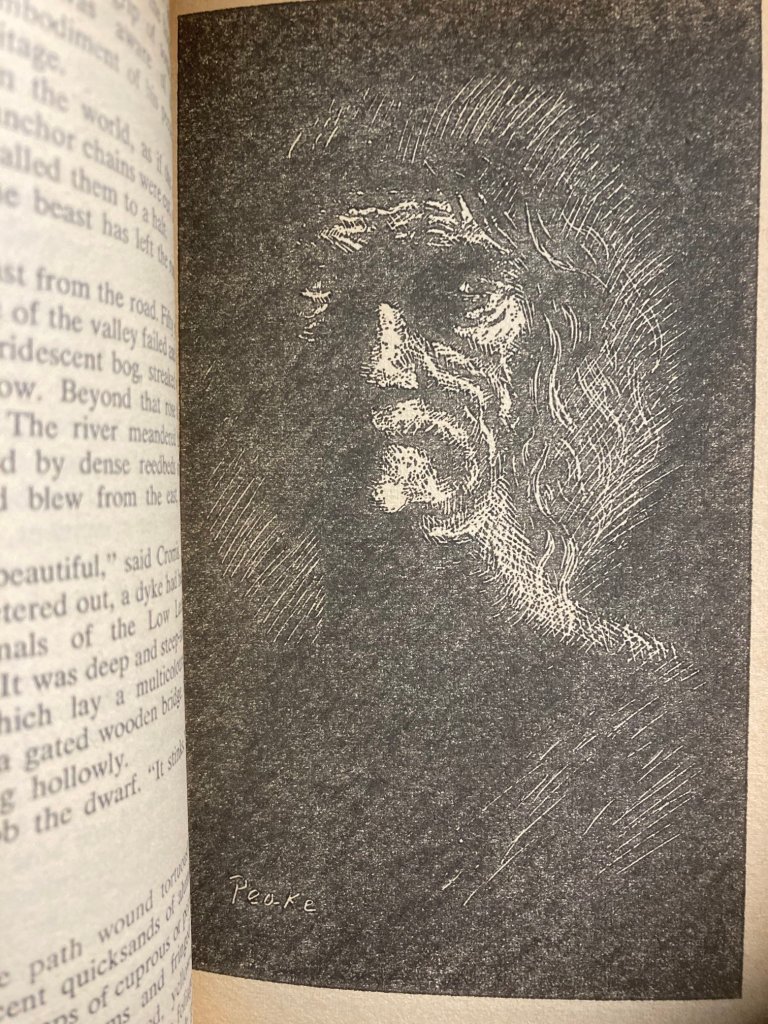
Mervyn Peake’s interior art for M. John Harrison’s “The Lamia and Lord Cromis”
4. New Voices II, ed. George R. R. Martin (1979)
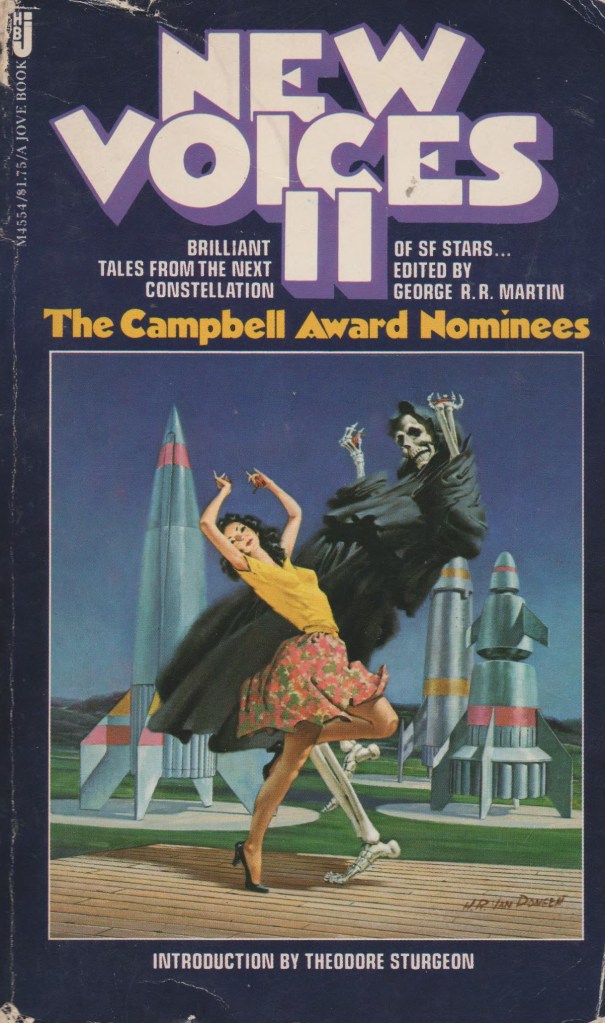
H. R. Van Dongen’s cover for the 1st edition
From the back cover: “The Hollow Man” by Lisa Tuttle. A doting wife has her husband brought back to life—but he’d have been better off dead.
“The Dancer in the Darkness” by Thomas F. Monteleone. She tried a dance the gypsies wouldn’t dare, a dance forbidden by the angel of death.
“Lady of Ice” by Guy Snyder. He destroyed his only lover—Betty, his starship computer.
“Satan’s Children” by Spider Robinson. What happens when a scientist synthesizes truth?
“Twilight Lives” by Jesse Miller. Warrior women ruled the planet. They took away his power to love–and gave him the power to kill.”
Initial Thoughts: I bought this anthology for one story — Jesse Miller’s “Twilight Lives.” I have a post in the making that pulls together as much information as I’ve been able to find on one of the handful of African-American SF authors active in the 70s. Stay tuned for my article/review!
For book reviews consult the INDEX
For cover art posts consult the INDEX
For TV and film reviews consult the INDEX
I bought all the re-launched Ace Specials as they came out and still have most of them. The Hercules Text was pretty good and made me a minor McDevitt fan. Lots of religious background which was a bit unexpected at the time but it’s an interesting read. I’ve kept this one and the first volumes of both his series.
I’ve read a good dozen of his books over the years and he’s usually pretty reliable although if you read his series books too close together you see the recurring plot mechanics a bit too clearly. I recommend his books regularly to people who want big, far future sf without all the space opera battles, etc!
I don’t recall the Simak stories from their titles so I can’t say for sure if I’ve read any of them, but he has written some v. good ones. Open Road Media have published 8 volumes of them so far!
Hello Mike! How are you? It’s good to hear from you — as always.
If you have any favorite Simak short stories let me know. I’ve read so many of his novels (I’d wager at least 12 although most pre-site) and so little of his short fiction.
As for McDevitt, he was an author I never encountered when I read newer SF (back in the early 2000s). I am, of course, most interested in his early work.
From your comment it seems you disagree with my immediate impression that, at least from the back cover blurb, the premise sounded bland? If so, that’s good to hear. Is his treatment of religion more complex then it tends to be in this sort of novel?
I’m fine; just re-opened after an enforced 4 month closure. Have to see if my customers come back again!
The Marathon Photograph or The Grotto of the Dancing Bear are both good, late Simak stories – I mention them here: https://www.flickr.com/photos/17270214@N05/6263925150
One of the main characters in the McDevitt is a priest so much of the dialogue and internal monologue is centred around the religious aspect of the signal and at the time certainly put me in mind of A case of Conscience by Blish. The church is key to the ending, too.
If you like Simak then you might like McDevitt’s Ancient Shores, set on the Great Pains up near the Canadian border and featuring a community I found similr to that in the tv series Longmuir (and the books by Craig Johnson). Remote township, farmers, nearby Native American reservation… and a millennia-buried space yacht!
I’ve also just noticed my notes on a McDevitt collection, Voice in the Night, in which I say:
“The longest story is Ships in the Night, which was, I’m reasonably sure, an homage to Clifford Simak and owed a lot both in tone and content to his novel Way Station.”
But I know that sometimes I make connections and see similariries which other people don’t.
I saw! I hope everything goes well with the opening.
I’ve not heard of “The Marathon Photograph.” I checked the isfdb.org listing — one of the collections both stories you list appeared in is The Marathon Photograph and Other Stories. It’s pricey online! And the first place it appeared is Threads of Time which is mostly made up of Spinrad’s “Ride the Torch” which I already own. Hm… not sure what to do. http://www.isfdb.org/cgi-bin/title.cgi?41171
While I might explore McDevitt’s SF further after I read The Hercules Text, 1996 is a bit too new for my current project. I’ll keep Ancient Shores (1996) in mind for later.
I’d offer as a side note that the reason the McDevitt isn’t a blah, bog-standard first contact story is that the Aliens do nothing, appear not at all, and the story’s about what humanity does with the realization that we are not alone.
Which also excuses, in my anti-religious mind, the inclusion of a priest as a PoV character.
Sounds like my type of first contact story! Aliens remain distant, a bit inscrutable, and profoundly alien….
Silverberg’s The Man in the Maze is a great example of this (not sure if it’s humanity’s first contact) treatment of the alien. Aliens mysteriously transform a man so that he is repulsive to his fellow humans. He becomes a pariah in a unusual ruined city where the main character has to track him down. You never learn why the aliens did what they did or if they even knew what they did. https://sciencefictionruminations.com/2012/02/05/book-review-the-man-in-the-maze-robert-silverberg-1969/
I think it’ll be your jam, Dr. B, and I will coddiwomple thitherward to read about the Agberg.
Agberg? A neologism or character in the novel? hah
“Ag” for “Silver,” get it? nudgenudge, winkwink
Ah, did not get that! Alas. The science part of science fiction goes right over my head.
I too bought the McDevitt as an Ace paperback and, indeed, had read the original serialization in ASIMOV’S, which apparently differed in some respects that I can’t recall.
JB: ‘Sounds like my type of first contact story! Aliens remain distant.’
It was McDevitt’s first novel and he worked hard to have it be a career-starter; it’s better than anything I’ve happened to see from him since. You may like it. I did.
But I was struck by its structural resemblances to Stanislaw Lem’s HIS MASTER’S VOICE, as if McDevitt had read the Lem first and thought: well, how can I take some of that, and then dumb it down for the middlebrow American SF market? Putting it another way, IIRC, it read kind of like a novelization of a script commissioned by Steven Spielberg if he were to decide to film HIS MASTER’S VOICE in a middle American setting (with parts for actors of the general whitebread morphology of Tom Hanks and John Lithgow).
As a huge fan of His Master’s Voice, I am intrigued by the comparison you made. As a complete separate and slightly silyl tangent — I will always remember how Lem describes the deserts in the American Southwest (if I remember correctly) as filled with sand dunes! Desert = must be the Sahara stereotype! hah. Silliness aside, His Master’s Voice reads, in parts, like a philosophical treatise so I am not against an attempt to narrow in on some of his main elements and construct a more traditional novel around them.
Mark, I looked up the 1st English translation of His Master’s Voice — 1983. McDevitt could have read it.
http://www.isfdb.org/cgi-bin/title.cgi?9130
That H. R. Van Dongen cover is kind of fun.
Still trying to figure out which story it illustrates! I think, as a manifestation of death, it’s illustrating Lisa Tuttle’s tale.
You mentioned above about recommendations for some favorite Simak stories. I have always been a fan of Simak’s pastoral style and probably read almost everything he wrote. Some of my favorite short stores are:
The Thing in the Stone
The Big Front Yard
Desertion
Not sure how I missed your comment — sorry!
Thank you for the list.